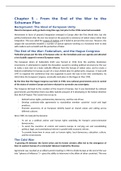Samenvatting
Summary EXAM MATERIAL European Governance 2022
- Vak
- Instelling
- Boek
This document contains everything that you need to know for the exam of the course European Governance at Utrecht University. It includes a summary of chapters 5-11 on the history of the EU, which are not discussed in the lectures, and it includes notes on all the lectures that are required for the...
[Meer zien]













